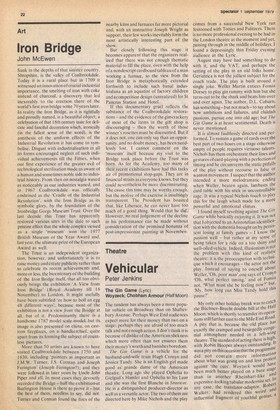Art
Iron Bridge
John McEwen
Sunk in the depths of that sinister country, Shropshire, is the valley of Coalbrookdale. Today it is a rural place but in 1709 it witnessed an innovation of crucial industrial importance, the smelting of iron with coke instead of charcoal, a discovery that led inexorably to the erection there of the world's first iron bridge some 70 years later. In reality the Iron Bridge, as it is rightfully and proudly named, is a beautiful object; a celebration of that 18th century taste for delicate and fanciful decoration which, ironically (in the fullest sense of the word), is the antithesis of the uniform effects of the Industrial Revolution it has come to symbolise. Disgust with industrialisation in all its forms encouraged neglect of such individual achievements till the Fifties, when our first experience of the greater evil of technological sterilisation made us aware of a human and sometimes noble side to industrial history. From then on nostalgia waxed as noticeably as our industries waned, and in 1967 Coalbrookdale was officially enshrined as the 'Cradle of the Industrial Revolution', with the Iron Bridge as its symbolic glory, by the foundation of the lronbridge Gorge Museum Trust. Over the last decade this Trust has apparently restored various sites in the dale to such pristine effect that the whole complex viewed as a single 'museum' won the 1977 British Museum of the Year Award and, last year, the ultimate prize of the European Award as well, The Trtist is an independent organization, however, and unfortunately it is to raise money and create publicity rather than to celebrate its recent achievements and, more or less, the bicentenary of the building of the Iron Bridge itself, that all too obviously brings the exhibition 'A View from Iron Bridge' ( Royal Academy till 18 November) to London. It might usefully have been subtitled 'or how to boil an egg 48 different ways', because most of the exhibition is not a view from the Bridge at all, but of it. Predominantly there is a handsome 1787 model scale model, but its. image is also presented on china, on castiron fireplaces, on a handkerchief, quite apait from its forming the subject of countless pictures.
More than 50 artists are known to have visited Coalbrookdale between 1750 and 1830, including 'painters as important las. .1.M,W: Turner, J.S. Cotman and Joseph Farington' (Joseph Farington?); and they were followed in later years by Untie John Piper and all. In most cases they devoutly recorded the Bridge — half the exhibition-at Burlington House is there to prove it — but the best of them, needless to say, did nOt. Turner and Cotman found the fires of the nearby kilns and furnaces far more pictorial and, with an instructive Joseph Wright as support, their few works inevitably form the most artistically interesting part of the show.
But closely following this stage it becomes apparent that the organizers realized that there was not enough thematic material to fill the place, even with the help of a nondescript cardboard tableau of a man working a furnace, so the view from the Iron Bridge is metaphorically extended forthwith to include such banal industrialana as an aquatint of factory children and a corn petition design (unrealized) for St Pancras Station and Hotel.
If this documentary gruel reflects the substance of the Coalbrookdale restorations and the evidence of the gimcrackery of most of the items in the gift shop is discouraging — then the worth of those winner's rosettes must be discounted. But if it does not, one can only say than an opportunity, and no doubt money, has been need. lessly lost. I cannot comment on the 'museum' itself because my visit to the Bridge took place before the Trust was born. As for the Academy, too many of their recent exhibitions have had this tacky air of promotional stop-gaps. They are in financial straits as everyone knows, but they could nevertheless be more discriminating. The cause this time may be worthy enough, but the motive of the exercise is insultingly transparent. The President has boasted that, like Liberace, he can never have too much of a good thing. Would that he did. However, no real judgement of the decline in his performance can he made without consideration of the promised bonanza of post-impressionist painting in November.






























 Previous page
Previous page